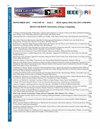AFERSM-Net: Joint Network for Gesture Recognition and Location Classification
IF 1.3
4区 工程技术
Q3 COMPUTER SCIENCE, INFORMATION SYSTEMS
引用次数: 0
Abstract
With the widespread deployment of wireless communication systems and smart devices, gesture recognition and indoor location classification technologies based on WiFi wireless devices are increasingly used. Its technical principle is to identify human activities and locations by extracting gesture and location features from WiFi channel state information (CSI). However, the signal is susceptible to interference from the environment during CSI data acquisition to produce multipath effect noise, and the amplitude change with the change of location often affects the extraction and recognition of gesture features. To address these problems, Auxiliary Feature Extraction based Residual Shrinkage Multi-tasking Network (AFERSM-Net) is proposed for gesture recognition and position classification of one-dimensional multivariate time series. AFERSM-Net is a hybrid architecture that combines CNN for spatial feature extraction and LSTM networks for capturing temporal dependencies. Firstly, a reasonable threshold is set adaptively by the shrinkage module to dynamically identify and eliminate the transformed environmental noise. Secondly, the feature extraction module is used to focus on and extract location-independent gesture features to reduce the influence of location-independent features. Finally, the gesture features extracted by the feature extraction module are fused with the shared features of the residual shrinkage multi-tasking network as an aid. Its module fusion is mainly used to improve the accuracy of gesture recognition and solve the problem of insufficient model generalization ability. We evaluated this network on a dual-labeled gesture and location dataset, an the gesture recognition accuracy was 97.84% and the location classification accuracy was 98.92%, which outperformed other advanced network frameworks.AFERSM-Net:手势识别和位置分类联合网络
随着无线通信系统和智能设备的广泛部署,基于WiFi无线设备的手势识别和室内位置分类技术得到越来越多的应用。其技术原理是通过从WiFi信道状态信息(CSI)中提取手势和位置特征来识别人类活动和位置。然而,在CSI数据采集过程中,信号容易受到环境的干扰而产生多径效应噪声,并且随着位置的变化而产生的幅度变化往往影响手势特征的提取和识别。针对这些问题,提出了基于辅助特征提取的残差收缩多任务网络(AFERSM-Net),用于一维多元时间序列的手势识别和位置分类。AFERSM-Net是一种混合架构,结合了用于空间特征提取的CNN和用于捕获时间依赖性的LSTM网络。首先,收缩模块自适应设置合理的阈值,动态识别和消除变换后的环境噪声;其次,利用特征提取模块对位置无关的手势特征进行关注和提取,减少位置无关特征对手势的影响。最后,将特征提取模块提取的手势特征与残差收缩多任务网络的共享特征融合作为辅助。其模块融合主要用于提高手势识别的准确率,解决模型泛化能力不足的问题。我们在双标记手势和位置数据集上对该网络进行了评估,手势识别准确率为97.84%,位置分类准确率为98.92%,优于其他先进的网络框架。
本文章由计算机程序翻译,如有差异,请以英文原文为准。
求助全文
约1分钟内获得全文
求助全文
来源期刊

IEEE Latin America Transactions
COMPUTER SCIENCE, INFORMATION SYSTEMS-ENGINEERING, ELECTRICAL & ELECTRONIC
CiteScore
3.50
自引率
7.70%
发文量
192
审稿时长
3-8 weeks
期刊介绍:
IEEE Latin America Transactions (IEEE LATAM) is an interdisciplinary journal focused on the dissemination of original and quality research papers / review articles in Spanish and Portuguese of emerging topics in three main areas: Computing, Electric Energy and Electronics. Some of the sub-areas of the journal are, but not limited to: Automatic control, communications, instrumentation, artificial intelligence, power and industrial electronics, fault diagnosis and detection, transportation electrification, internet of things, electrical machines, circuits and systems, biomedicine and biomedical / haptic applications, secure communications, robotics, sensors and actuators, computer networks, smart grids, among others.
 求助内容:
求助内容: 应助结果提醒方式:
应助结果提醒方式:


